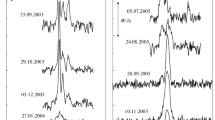Abstract
The monitoring results of the OH maser source in W75 N in the main line at 1667 MHz and satellite line at 1720 MHz performed in 2007–2020 using Nancay Radio Telescope (France) are presented. Generally, the maser in 2007–2009 is characterized by high activity in all lines, except for 1612 MHz, where the emission is thermal. During the monitoring, strong time variations in the flux density and polarization parameters were found for most spectral features. We found that the degree of circular polarization (\({{m}_{{\text{C}}}}\)), as well as the degree (\({{m}_{{\text{L}}}}\)) and polarization angle (\(\chi \)) of linear polarization, change with time according to certain regularities, or change very little. There is a correlation between the variability of these parameters and the variability of the flux density. In this case, the radial velocities of the features change very little. The identification of spectral features in both lines (1667 and 1720 MHz) with maser spots on VLBA maps obtained in April 2008 has been carried out. We have identified seven spectral features in the 1667 MHz line and eleven in the 1720 MHz line. They are located in different parts of a large arc and well illustrate the fact that the orientation of the magnetic field vector changes more or less monotonically along the arc. The maser spots projected onto the VLA 2 (Keplerian disk) have been identified with seven spectral features in the 1667 MHz line. They form a small arc that is directed away from VLA 2. The magnetic field vectors associated with maser spots are oriented perpendicular to this arc. After flares of emission at 0.38 and 1.2 km/s, the magnetic field vectors of these features became oriented along the arc. For three Zeeman pairs in the 1667 MHz line (VLA 2), the magnitude of the longitudinal magnetic field was determined. In all cases, the field is directed towards the observer. For two features (–4.9 and 1.2 km/s), a monotonic change in the position angle by 140° and 110° was found, while the rate of rotation of the polarization plane is 5°/month and 7°/month, respectively. It was found that during a short-term flare of the 5.3 km/s feature in VLA 1, all polarization parameters changed, and after the flare, all of them were restored.















Similar content being viewed by others
REFERENCES
K. L. J. Rygl, A. Brunthaler, K. M. Menten, M. J. Reid, et al., in Proceedings of the 10th European VLBI Network Symposium and EVN Users Meeting VLBI and the New Generation of Radio Arrays, September 20–24, 2010 (Manchester, UK), p. 103. http://pos.sissa.it/cgi-bin/reader/conf.cgi?confid= 125.
J. M. Torrelles, J. F. Gómez, L. F. Rodrígez, P. T. P. Ho, S. Curiel, and R. Vazquez, Astrophys. J. 489, 744 (1997).
C. G. Wynn-Williams, E. E. Becklin, and G. Neugebauer, Astrophys. J. 187, 473 (1974).
J. M. Torrelles, L. A. Patel, G. Anglada, J. F. Gómez, et al., Astrophys. J. 598, L115 (2003).
E. E. Lekht, V. I. Slysh, and V. V. Krasnov, Astron. Rep. 51, 967 (2007).
V. L. Fish, M. Gray, W. M. Goss, and A. M. S. Richards, Mon. Not. R. Astron. Soc. 417, 555 (2011).
V. L. Fish, M. J. Reid, A. L. Argon, and X.-W. Zeng, Astrophys. J. Suppl. 160, 220 (2005).
P. Colom, N. T. Ashimbaeva, E. E. Lekht, M. I. Pashchenko, G. M. Rudnitskii, and A. M. Tolmachev, Astron. Rep. 65, 45 (2021).
M. D. Gray and D. Field, Astron. Astrophys. 298, 243 (1995).
R. D. Davies, R. S. Booth, and J.-N. Perbet, Mon. Not. R. Astron. Soc. 181, 83 (1977).
P. Goldreich, D. A. Keely, and J. Y. Kwan, Astrophys. J. 179, 111 (1973).
V. I. Slysh, M. I. Pashchenko, G. M. Rudnitskii, V. M. Vitrishchak, and P. Colom, Astron. Rep. 54, 599 (2010).
T. R. Hunter, G. B. Taylor, M. Felli, and G. Tofani, Astron. Astrophys. 284, 215 (1994).
V. S. Strelnitski, J. Alexander, S. Gezari, B. P. Holder, J. M. Moran, and M. J. Reid, Astrophys. J. 581, 1180 (2002).
V. I. Slysh, A. V. Alakoz, and V. Migenes, Mon. Not. R. Astron. Soc. 404, 1121 (2010).
V. I. Slysh, V. Migenes, I. E. Val’tts, S. Yu. Lyubchenko, S. Horiuchi, V. I. Altunin, E. B. Fomalont, and M. Inoue, Astrophys. J. 564, 317 (2002).
ACKNOWLEDGMENTS
The authors express their gratitude to the staff of the Meudon Radio Astronomy Observatory (France) for their great assistance in carrying out observations at the Large Radio Telescope in Nancay during the long period of monitoring. The authors also express their gratitude to the anonymous referee for useful comments and suggestions that improved the quality of our paper.
Author information
Authors and Affiliations
Corresponding author
Additional information
Translated by E. Seifina
Rights and permissions
About this article
Cite this article
Ashimbaeva, N.T., Lekht, E.E., Pashchenko, M.I. et al. Evolution of OH Maser Emission in the Active Star-Forming Region W75 N. II. Research in the 1667 and 1720 MHz Lines. Astron. Rep. 66, 648–668 (2022). https://doi.org/10.1134/S1063772922090025
Received:
Revised:
Accepted:
Published:
Issue Date:
DOI: https://doi.org/10.1134/S1063772922090025




